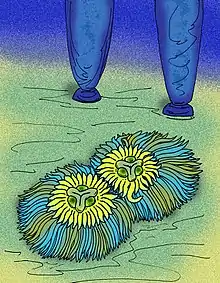Pomoria
Pomoria corolliformis is an Ediacaran fossil that Mikhail Fedonkin described as resembling a modern-day sea anemone. The only known fossil specimen appears to have a long, gut-like tube that connects to its mouth and have circular protrusions that resemble modern cnidarian tentacles.
| Pomoria Temporal range: Ediacaran | |
|---|---|
 | |
| artist's reconstruction | |
| Scientific classification | |
| Kingdom: | |
| (unranked): | |
| Genus: | Pomoria Fedonkin, 1980 |
| Species: | P. corolliformis |
| Binomial name | |
| Pomoria corolliformis Fedonkin, 1980 | |
Description
P. corolliformis has tri-radial symmetry, leading to its identification as a trilobozoan.[1] The prenutal fin is surrounded by the projecting manubrium. The manubrium, the tube bearing the mouth of a coelenterate, is described as being quite long, with a lateral cross section showing lateral semicircular protrusions. The thickness of the manubrium is 2 or 3 times the thickness of the tentacle.[2]
Diversity
Pomoria corolliformis is the only species that has been described.[2]
Discovery
Mikhail Fedonkin first described Pomoria in 1980 in his publication in Palaeontology, New representation of the Precambrian. Fedonkin found Pomoria in the northern Russia platform in the Vendian Complex.[2][3]
Distribution
The only known specimen, representing two individuals situated closely together, is from the Late Precambrian-aged Winter Shore of the White Sea, Russia.
Significance
Pomoria went extinct during the late Ediacaran and can be regarded as an example of the "evolutionary failure" of triradial symmetry.[1]
References
- Droser, Mary L.; Tarhan, Lidya G.; Gehling, James G. (2017). "The Rise of Animals in a Changing Environment: Global Ecological Innovation in the Late Ediacaran". Annual Review of Earth and Planetary Sciences. 45 (1): 593–617. doi:10.1146/annurev-earth-063016-015645. ISSN 0084-6597.
- Fedonkin, M. A. (1980). "New representative of the Precambrian coelenterates in the northern Russian platform". Paleontologicheskii Zhurnal. 5: 7–15.
- De, C.; Prasad, S. (2004). "Discovery of Vendian Ediacaran fossil assemblage from the Marwar Super group, Rajasthan, India". Indian Journal of Geosciences. 65 (3): 241–242.